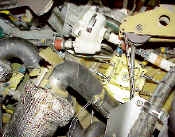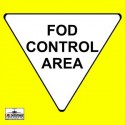Compliments of U.S. Navy “Mech” Magazine
By AM3 Edgar Crook
It was a hot, muggy, summer day in the Persian Gulf, and, as usual, I had a full day’s work ahead of me. Aircraft 403 was moved down to the hangar for a Phase C, 7- through 84-day, and 200-, 400-, and 600-hour inspections. The Hornet’s Phase C includes a look at all flight-control servocylinders-not a tough inspection, but we made it harder than necessary.
 We started removing panels at 0800 for the Phase C and the 42-day inspections. To save time, the two other airframers and I planned to clean the panels as we worked. We grabbed some rags, spray-cleaning compound, corrosion-preventive compound, and headed out to the aircraft. As soon as we were done with our job, the shop CDI inspected the panels for cleanliness. He gave them a long, hard look, and after getting his stamp of approval, we re-installed the panels. We then went to work on other sections of the phase and the 200- and 400-hour inspection. Our day ended at 1830, and it was night check’s turn to sweat and to finish the rest of the Phase C.
We started removing panels at 0800 for the Phase C and the 42-day inspections. To save time, the two other airframers and I planned to clean the panels as we worked. We grabbed some rags, spray-cleaning compound, corrosion-preventive compound, and headed out to the aircraft. As soon as we were done with our job, the shop CDI inspected the panels for cleanliness. He gave them a long, hard look, and after getting his stamp of approval, we re-installed the panels. We then went to work on other sections of the phase and the 200- and 400-hour inspection. Our day ended at 1830, and it was night check’s turn to sweat and to finish the rest of the Phase C.
It took almost two weeks to finish the inspections and to fix a few outstanding gripes, but the aircraft still had a few maintenance checks to complete before it was ready for flight. We did a maintenance turn in the hangar bay, and everything checked out. We took hydraulic and engine-oil samples and measured flight-control-surface clearances, and all checked 4.0.
 After we signed off the Phase C, 200-, 400-, and 600-hour inspections, the aircraft was moved to the flight deck. The Hornet flew for the first time in nearly two weeks and continued to fly every day for two weeks without any problems.
After we signed off the Phase C, 200-, 400-, and 600-hour inspections, the aircraft was moved to the flight deck. The Hornet flew for the first time in nearly two weeks and continued to fly every day for two weeks without any problems.
One night, though, a pilot reported to the flight-deck controller that the “beer cans” (wingfold-lock indicators) were stuck, indicating the wings would not spread and lock. The airframes night-check crew removed panel 34 (right) to investigate the problem. They were shocked to find a rag wrapped around the short shaft that drives the leading-edge flaps. The rag had wrapped around the wingfold control cable and had snapped it in half. They removed the cable and installed a new one, which required a rig check.
That rag easily could have locked up the leading-edge flap and caused an in-flight emergency. What scares me most is we could have lost the aircraft or, even worse, killed a pilot.
 This entire mess could have been avoided if we had taken our time and thought about what we had to do. It was very hot in the hangar, and we had rushed to get the panels back on for the phase and 42-day inspection. We must have kicked that rag into the wingfold-lock area before reinstalling the panels and after the CDI had completed his check.
This entire mess could have been avoided if we had taken our time and thought about what we had to do. It was very hot in the hangar, and we had rushed to get the panels back on for the phase and 42-day inspection. We must have kicked that rag into the wingfold-lock area before reinstalling the panels and after the CDI had completed his check.
Since this incident, we now require a QAR and CDI to inspect the inside of all panel areas, and then we install the panels while they watch. We also are required to look inside any panel that contains hydraulic lines or a flight-control servo. Our squadron now has made rags a part of our tool-checkout procedures. If we check out three rags for a job, we have to bring three rags back to the shop. We show them to the supervisor or CDI and then sign the log’s return block.
Since that day, I have been much more cautious about how I do maintenance. I realized a 25-cent rag could have brought down a multi-million-dollar aircraft!
Petty Officer Crook works in the airframes shop at VFA-87.
Analyst comment: If you think this never could happen to you, you’re wrong! During the last 10 surveys, only three squadrons had established a rag-control program. Of those three, one had a rag in its FOD walkdown bag and another had maintainers who weren’t familiar with the rag-inventory procedures. If your squadron doesn’t have a rag-control program, you need to develop one, and make it part of your tool-checkout procedures. Once the program is established, take time to make sure all workcenters are aware of and comply with it.-CWO3 Tom Gaine is a maintenance analyst at the Naval Safety Center.



